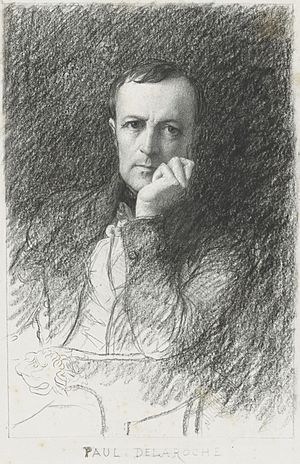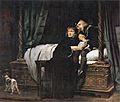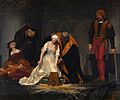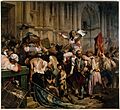Paul Delaroche facts for kids
Quick facts for kids
Paul Delaroche
|
|
|---|---|

Self-portrait
|
|
| Born |
Hippolyte-Paul Delaroche
17 July 1797 Paris, France
|
| Died | 4 November 1856 (aged 59) Paris, France
|
| Education | École des Beaux-Arts |
| Known for | Painting |
|
Notable work
|
The Execution of Lady Jane Grey (1833) |
| Movement | Romanticism |
| Spouse(s) |
Louise Vernet
(m. 1835) |
Hippolyte-Paul Delaroche (French pronunciation: [ipɔlit pɔl dəlaʁɔʃ]; 17 July 1797 – 4 November 1856) was a French painter. He was best known for his historical paintings. His artworks often showed dramatic scenes from English and French history.
Delaroche's paintings mixed the strong feelings of Romanticism with the careful details of Academicism. He wanted to show history and people as realistically as possible. He painted everyone, from queens like Marie Antoinette to leaders like Napoleon Bonaparte, in a similar way. Delaroche was a top student of Antoine-Jean Gros. Later, he taught many famous artists, including Thomas Couture and Jean-Léon Gérôme.
Delaroche lived when two art styles, Romanticism and Classicism, were popular. He found a way to combine both. His historical paintings appealed to Romantics because of their stories. Their detailed surfaces appealed to those who liked Academic art. His most famous painting, The Execution of Lady Jane Grey (1833), shows this mix.
Contents
Paul Delaroche's Life Story
Paul Delaroche was born in Paris in 1797. He came from a family of artists and art dealers. His father, Gregoire-Hippolyte Delaroche, was a well-known art dealer.
At age nineteen, Paul began studying at L'École des Beaux-Arts. He first focused on landscapes, but he soon found them boring. He left the school in 1817. The next year, he joined the studio of Antoine-Jean Gros. There, he could follow his real passion: history painting.
Becoming a Famous Artist
Delaroche first showed his paintings at the Salon in 1822. One of his works, Jehosheba Saving Joash, was praised by Théodore Géricault. Géricault was a key figure in the Romantic art movement.
Delaroche's training gave him a love for careful detail. But his time with Gros sparked his interest in dramatic history. His painting Joan of Arc in Prison (1824) showed this blend of styles. He also studied English history paintings. This led him to create works like Death of Queen Elizabeth (1828).
His focus on English history made him very popular in Britain. In the 1830s, he painted some of his most famous works. These include Cromwell Gazing at the Body of Charles I (1831) and The Princes in the Tower (1831). His most celebrated piece was The Execution of Lady Jane Grey (1833).
Because of his talent, Delaroche became a member of the Académie des Beaux-Arts in 1832. A year later, he became a professor at L’Ecole des Beaux-Arts.
Painting History with Drama
As a history painter, Delaroche wanted to show historical events in a thoughtful way. He tried to be true to the facts, even if he sometimes added drama. He carefully researched the clothes, objects, and settings in his paintings. This helped him make his scenes look accurate.
He used clear lines and fine details in his work. This made each person in his paintings look unique. He wanted his paintings to tell a story. He balanced the historical facts with the visual drama of his scenes.
Famous Historical Paintings
Some of Delaroche's dramatic paintings include:
- Strafford Led to Execution: This shows Archbishop Laud blessing Thomas Wentworth, 1st Earl of Strafford before his execution.
- The Assassination of the duc de Guise at Blois.
- A painting showing Cardinal Richelieu's grand boat. It is followed by a boat carrying Cinq-Mars and De Thou to their execution.
- The Princes in the Tower, showing two young princes who disappeared.
- La Jeune Martyre, which depicts a young female martyr floating in the Tiber river.
Sometimes, Delaroche changed history a bit for dramatic effect. For example, Cromwell lifting the Coffin-lid and looking at the Body of Charles is based on an old story, not a proven fact. He cared more about making a powerful scene than perfect historical accuracy.
Later Career and The Hemicycle
After 1837, Delaroche stopped showing his work in public art shows. He then started his most famous work, The Hemicycle. This was a huge mural painted at L’Ecole des Beaux-Arts.
The Hemicycle was 27 meters (88.5 feet) long. It showed over seventy of the most famous artists from history. These artists represented different periods, like Gothic, Greek, Roman, and Renaissance art.
Delaroche used a special painting method called encaustic for this mural. This involves mixing paint with hot wax. He worked on this project from 1837 to 1841 with the help of four of his students. In 1855, a fire badly damaged the work. Delaroche spent his last year trying to fix it. He died in 1856, and his student Tony Robert-Fleury finished the restoration.
The painting shows 75 great artists from all time periods. They are talking in groups around white marble steps. On the top steps are three creators of the Parthenon: sculptor Phidias, architect Ictinus, and painter Apelles. They represent how these arts are connected. Female figures, like muses, also appear, symbolizing different arts.
Personal Life
Paul Delaroche married Louise Vernet in 1835. She was the daughter of his father-in-law, Horace Vernet. Delaroche loved Louise very much. He even painted Head of an Angel based on her. Sadly, Louise died in 1845 when she was only 31. It is said that Delaroche never fully recovered from her death. After she passed away, he painted a series of small pictures about Jesus's Passion. He focused on the human feelings in these religious scenes.
Paul Delaroche and Photography
Paul Delaroche is famous for a quote: "from today, painting is dead." He likely said this in 1839. This was when he first saw examples of the Daguerreotype. This was the first successful way to take photographs. He might have felt that photography would change the world of art forever.
Images for kids
-
Strafford led to Execution, 1836
-
Charles I Insulted by Cromwell's Soldiers, 1836, thought lost in The Blitz, rediscovered in 2009
-
Peter the Great, 1838
-
Herodias, 1843, Wallraf-Richartz-Museum, Cologne, Germany.
See also
 In Spanish: Paul Delaroche para niños
In Spanish: Paul Delaroche para niños
- Charles I Insulted by Cromwell's Soldiers, the 1836 Delaroche painting thought lost in the Blitz, rediscovered in 2009.
















